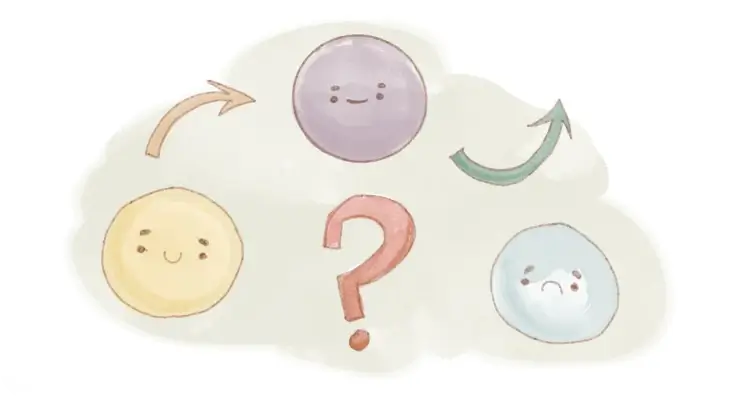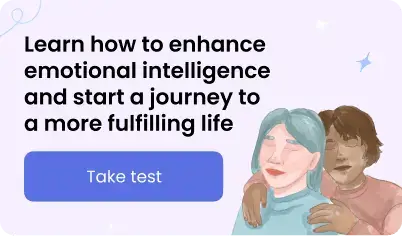Life is a rollercoaster of human emotions. We get happy, we get sad, and we get startled by the spiders. Yet, to have a peaceful mind, it’s crucial not only to feel basic emotions but also to understand them. Understanding how human emotions function is essential for managing life’s challenges and taking better care of yourself. Knowing your EQ code and how to improve it will definitely help you.
What are human emotions?
Emotions are our mental reactions to the events and experiences we face, which trigger physiological and behavioral changes. This definition is based on the APA Dictionary of Psychology, which breaks down basic human emotions into three parts:
- Experiential
- Physiological
- Behavioral
1. The experiential element
It includes the kind of emotion we’re feeling, how intense it is, and how much attention we give it. Even though everyone has similar basic human emotions (we’ll discuss those later), the same thing can trigger different reactions in each of us.
To give you a clearer picture, let’s say you’re in the park with your friend, and suddenly, “Someone Like You” by Adele starts playing on someone’s phone nearby. This song might remind you of dancing at a party with your first love, making you feel nostalgic and happy. On the other hand, your friend might associate it with a recent breakup and get sad.
The experiential element of emotions comes to us unconsciously. But even though you can’t control it, you must learn to identify this element correctly to meet your emotional needs.
2. The physiological element
The physiological element in types of human emotions is the way our body responds to emotional stimuli. It can vary based on personal experiences and the context of the emotional experience. But the most common examples include changes in:
- Heart rate. It goes up when you’re happy and can rise quickly when you’re angry or frightened.
- Facial expression. We smile for joy, cry when upset, our faces flush when we’re angry, our eyes widen when we’re surprised, we wrinkle our noses for disgust, and so on.
- Breathing patterns. Sadness is linked to sighs, anger, and fear—to quick and shallow breaths and surprise—to a sudden gasp.
- Muscle tension. When we’re happy, we’re generally relaxed. Anger increases tension in the jaw, shoulders, and fists. Disgust tightens facial muscles and the stomach area.
Now, we have two elements of human emotions—one is unconscious, and the other is involuntary. So, can we control our primary emotions, or do they control us? Actually, the behavioral part holds the answer.
3. The behavioral element
The behavioral element is how we express our emotions. Sometimes, it’s closely interconnected with the physiological element. For instance, certain facial expressions, like smiling, can be part of both.
Human emotions are complex reactions, meaning that changes in our feelings, bodies, and actions don’t happen in isolation; they are linked.
The physiological part of facial expressions involves muscle contractions in the face. However, when we smile, it’s not just because our facial muscles are involuntarily activated; we can also smile because we want to.
This behavioral element of emotions can manifest itself through:
- Body language: posture, gestures, movements
- Verbal expression: choice of words, tone of voice, voice volume
- Coping strategies: seeking support, mindfulness techniques, physical exercises, etc.
This behavioral element in human types of emotions is influenced by an individual’s cultural background. For example, a cross-cultural study by Lu and Gilmour suggests that Americans consider happiness as “being upbeat” and energetically positive. [1] Meanwhile, the Chinese understanding leans towards a more solemn and reserved expression.
Involving visible actions and expressions, the behavioral element allows us to communicate our emotions and understand what others are feeling. That’s a key aspect of social interactions and interpersonal relationships.
But the most important thing is that the behavioral element contains a lot of deliberate aspects. We can choose strategies for different situations and change them as needed.
Complex and basic types of emotions
Which emotion are you feeling? Is it anger or envy? Guilt or just sadness? They are commonly categorized into two types of emotions: basic and complex.
To help you better recognize emotions in yourself and others, let’s look into each of these categories.
Basic emotions
Basic emotions are fast, universal, and ingrained in our nature. They originated as responses to challenges faced by our ancestors, which is why these types of emotions are sometimes referred to as “primary.”
The classic theory identifies six basic emotions: happiness, sadness, anger, fear, disgust, and surprise. They were identified by Paul Ekman, an American psychologist, at the end of the 20th century. [2]
Initially, Ekman included contempt as the seventh basic emotion but later dropped it because it wasn’t as clear and universally recognized as the other six. However, Ekman’s theory is not the only one in the field of emotional psychology.
New research published in the journal Current Biology by scientists at the University of Glasgow suggests that there are only four basic emotions. [3] These researchers insist that fear, surprise, anger, and disgust are so similar that they should be combined.
While there are numerous theories about human primary emotions, we’ll stick with Ekman’s for now, as it’s the most widely recognized concept. The classic Ekman’s list is commonly found in different articles on the topic and emotion quizzes.
1. Happiness
Happiness encompasses various mental states like contentment, joy, satisfaction, optimism, and pleasure. In Ekman’s theory, it stands out as the only emotion considered positive.
But beyond making us feel good, what’s the purpose of happiness as a basic human emotion? Primarily, it fuels our motivation. It guides us in identifying activities that bring joy and fulfillment, encouraging us to pursue them.
Numerous studies explore the causes of happiness, considering factors like genes, life circumstances, money habits, and experiences. [4] However, the key takeaway is that happiness is a subjective emotion.
What brings happiness to one person might not work for another. We must also understand that happiness isn’t a final destination or a permanent state of mind. Like other basic emotions examples, it is temporal and fluctuating. No one feels happy all the time.
2. Sadness
What type of feeling are you experiencing when you’re sad? For most people, the list includes loss, sorrow, melancholy, despair, and disappointment. Here is how this type of emotion can be expressed:
- Facial Expressions: Frowning, drooping eyelids, a downturned mouth.
- Body Language: Slumped posture, slow or minimal movements.
- Tone of Voice: Low-pitched, slow, soft, and monotone.
Even though sadness is often seen as a negative primary emotion, it’s actually a healthy and adaptive response to unmet expectations. It’s a signal that communicates to others that we might need support.
Feeling upset when things don’t go as planned is entirely normal, whether it’s about something tangible, like a salary increase, or intangible, like not receiving mutual feelings from someone we love.
3. Anger
Anger is characterized by irritability, frustration, resentment, aggression, and annoyance. It surfaces when we sense threats, provocations, or injustices, triggering our natural instinct to protect ourselves.
- Facial Expressions: Tightly furrowed brows, glaring eyes, a clenched jaw, and lips pressed firmly together or pursed.
- Body Language: Rigid posture, clenched fists, abrupt or forceful movements, or pacing.
- Tone of Voice: Loud, sharp, intense, and often with a cutting or abrupt tone.
While anger is a normal and common emotion example, it’s essential to express it in healthy ways.
4. Fear
Fear is closely associated with feelings of apprehension, nervousness, dread, and insecurity. These basic emotions often arise in response to the perceived threat, which can be either real, like being chased by a lion, or imagined, such as the fear of flying.
When we consider all human emotions, fear is probably the one that has contributed the most to our survival. Thanks to fear, our ancestors ran away from wild animals and avoided dangerous situations like jumping from high, sharp rocks.
Besides being jumpy, when we feel fear, we also might have wide eyes, raised eyebrows, tensed bodies, defensive posture, and rapid speech.
However, extreme or irrational fears can lead to anxiety and phobias. According to the American Psychiatric Association, anxiety affects nearly 30% of adults, which makes it the most common mental disorder. [5]
5. Disgust
Disgust manifests in aversion, repulsion, revulsion, contempt, and loathing. The primary role of disgust as a basic human emotion is to steer us away from potentially unpleasant situations. Here is how this type of emotion can be shown:
- Facial Expressions: Wrinkled nose, raised upper lip, narrowed eyes.
- Body Language: Turning away, recoiling, or creating distance.
- Tone of Voice: Low, curt, with a tone of disdain or disapproval.
6. Surprise
Surprise is related to mental states like astonishment, bewilderment, curiosity, and uncertainty. It typically occurs in response to something new or unexpected. Here is how it can be expressed:
- Raised eyebrows, wide-open eyes, mouth agape
- Sudden movements, hands brought to the face or chest.
- Brief exclamations, often high-pitched, with rapid changes in inflection.
The main goal of these primary emotions is to draw our attention to what’s happening around us so we can determine whether it’s dangerous or not. In essence, the emotion of surprise helps us quickly shift our focus, evaluate the situation, and respond effectively to new information.

Complex emotions
Complex emotions, as defined by the APA Dictionary of Psychology, are blends of two or more basic emotions. Unlike automatic primary emotions, they involve higher cognitive processes and rely heavily on individual interpretations of events.
Given the intricate nature of this category of human emotions, there is no exhaustive list or clear-cut definitions. Much depends on the specific context an individual experiences. But here are a few simplified emotions examples:
- Envy: Desiring something possessed by someone else, often accompanied by emotions of anger and sadness.
- Hate: Intense dislike of something or someone, typically combining basic emotions like anger, fear, and disgust.
- Guilt: Regretting actions, words, or behavior, often comprising sadness, fear, and anger.
- Embarrassment: Experiencing a violation of social norms, expectations, or personal standards, typically mixing sadness and fear.
How to build healthier relationships with your human emotions?
A quick disclaimer: We don’t encourage you to suppress your emotions in any way. Our goal is to provide you with helpful tips on how to live a harmonious, healthy life, enjoying and using them.
1. Enhance your emotional intelligence
Emotional intelligence is the ability to comprehend and manage our own emotions while also understanding and empathizing with the feelings of others. It helps us effectively build positive relationships, communicate effectively, and resolve conflict.
Earlier in this article, we explored the behavioral element of human emotions examples, mentioning that it’s the way we express our feelings. This element is closely intertwined with emotional intelligence. When we can effectively express and control our emotions through our behavior and understand the emotions of others, our social connections strengthen.
3. Learn healthy coping strategies
A coping strategy is a deliberate behavior we use to manage our emotions. These strategies vary depending on our individual preferences, personality, and the nature of the stress we face.
Generally, they are divided into healthy and unhealthy. Healthy strategies help us deal with our emotions in a self-caring manner without causing harm to us. Examples include:
- Seeking support from a mental health professional or your close ones
- Practicing mindfulness, meditation, and breathing techniques
- Regular physical exercise
- Embracing a healthy lifestyle, including proper nutrition, sufficient sleep, and limiting alcohol intake
- Engaging in activities that make you happy
4. Fight negative patterns in thinking and cognitive distortions
Negative patterns in thinking are our habit of processing events, information, and experiences pessimistically. For example, through catastrophizing, black-and-white thinking, labeling, and overgeneralization. Meanwhile, cognitive distortions refer to systematic patterns of negative thinking.
Negative thinking patterns and cognitive distortions affect our primary emotions. They exaggerate a sense of threat, trigger feelings of frustration and hopelessness, downplay positive experiences, and so on. Consequently, our emotions of fear or sadness become more intense without objective reasons, while our happiness decreases.
Conclusion
Human emotions are a natural part of the human experience. They help us understand what we need and build relationships with others. While we may not always control our basic emotions, we retain the power to choose our responses to them.
If you learn and monitor your emotions instead of ignoring them, stick to healthy coping strategies over harmful ones, and dispel negative thinking rather than rely on cognitive distortions, you’ll surely pave the way for a healthier and happier life.
Sources
- Nangyeon Lim, Cultural differences in emotion: differences in emotional arousal level between the East and the West, Integrative Medicine Research, Volume 5, Issue 2, 2016, https://doi.org/10.1016/j.imr.2016.03.004.
- Ekman P. (1999). Basic emotions. In Dalgleish T., Power M. J. (Eds.), Handbook of cognition and emotion (pp. 45–60). John Wiley.
- Jack, Rachael & Garrod, Oliver & Schyns, Philippe. (2013). Dynamic Facial Expressions of Emotion Transmit an Evolving Hierarchy of Signals over Time. DOI:10.1016/j.cub.2013.11.064
- Lyubomirsky, S., Dickerhoof, R., Boehm, J. K., & Sheldon, K. M. (2011). Becoming happier takes both a will and a proper way: an experimental longitudinal intervention to boost well-being. Emotion (Washington, D.C.), 11(2), 391–402. https://doi.org/10.1037/a0022575
- Penninx, B. W., Pine, D. S., Holmes, E. A., & Reif, A. (2021). Anxiety disorders. Lancet (London, England), 397(10277), 914–927. https://doi.org/10.1016/S0140-6736(21)00359-7
Disclaimer
This article is for general informative and self-discovery purposes only. It should not replace expert guidance from professionals.
Any action you take in response to the information in this article, whether directly or indirectly, is solely your responsibility and is done at your own risk. Breeze content team and its mental health experts disclaim any liability, loss, or risk, personal, professional, or otherwise, which may result from the use and/or application of any content.
Always consult your doctor or other certified health practitioner with any medical questions or concerns
Breeze articles exclusively cite trusted sources, such as academic research institutions and medical associations, including research and studies from PubMed, ResearchGate, or similar databases. Examine our subject-matter editors and editorial process to see how we verify facts and maintain the accuracy, reliability, and trustworthiness of our material.
Was this article helpful?




